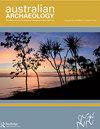Earth oven cookery and cuisines in Aboriginal Australia: Ethnographic and ethnohistoric insights from Western Cape York Peninsula and the Southern Murray Darling Basin
IF 1.2
3区 历史学
Q2 ANTHROPOLOGY
引用次数: 3
Abstract
Abstract Earth oven cookery involves cooking food in pits using hot heating elements, typically over extended periods of time. This technique has been reported in Holocene and Late Pleistocene contexts in Australia, and is of ongoing importance to many Indigenous peoples today. Despite considerable previous work on earth ovens and related sites, few have explored earth oven cookery as a distinctive cultural phenomenon. Here, we investigate the foodways associated with earth ovens drawing on ethnohistoric and ethnographic sources from the southern Murray-Darling Basin and central Western Cape York Peninsula, Australia. While there are many commonalities in earth oven cookery, it was also a highly adaptable practice in terms of the range of foods cooked, oven construction practices, and cooking techniques. People widely used herbs and wrappings to flavour foods, added water to aid the cooking process, and made extensive use of other plant materials to impart flavour, prevent food from burning, while also keeping food free of debris. We show that earth ovens are strongly associated with culturally distinctive cuisines and foodways and an investigation of these cookery practices can enhance our understanding of past social organisation, identity, commensality and the scale of food production.澳大利亚原住民的土炉烹饪和美食:来自约克角半岛西部和墨累-达令盆地南部的民族志和民族历史见解
摘要土炉烹饪涉及到使用加热元件在坑中烹饪食物,通常需要长时间。据报道,这项技术在澳大利亚的全新世和更新世晚期已经出现,对今天的许多土著人民来说具有持续的重要性。尽管之前对土炉和相关遗址进行了大量的研究,但很少有人将土炉烹饪作为一种独特的文化现象来探索。在这里,我们利用澳大利亚墨累-达令盆地南部和约克角半岛中西部的民族历史和民族志资料,调查了与土烤炉相关的饮食方式。虽然土炉烹饪有许多共性,但就烹饪的食物范围、烤箱结构实践和烹饪技术而言,它也是一种适应性很强的实践。人们广泛使用草药和包装来给食物调味,加水来帮助烹饪过程,并广泛使用其他植物材料来赋予味道,防止食物燃烧,同时保持食物没有碎屑。我们发现,土烤炉与文化特色的美食和饮食方式密切相关,对这些烹饪实践的调查可以增强我们对过去社会组织、身份、普遍性和食品生产规模的理解。
本文章由计算机程序翻译,如有差异,请以英文原文为准。
求助全文
约1分钟内获得全文
求助全文

 求助内容:
求助内容: 应助结果提醒方式:
应助结果提醒方式:


